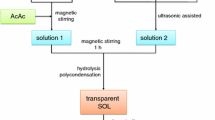Abstract
Dysprosia (Dy2O3) and dysprosia-doped ZrO2 (~10 wt% Dy2O3) samples were subjected to calorimetric and thermal analyses to understand the effect of dysprosia doping on the thermal properties of ZrO2 and to compare the thermal conductivity of dysprosia-doped ZrO2 (DySZ) to standard 7YSZ (7 wt% Y2O3 in ZrO2). All doped samples were plasma sprayed and subsequently sintered to ensure material densification (reduced porosity for bulk property analysis) and sufficient diffusion of constituents throughout the samples. Differential scanning calorimetry was used to measure the specific heat capacity values for powder and sintered samples as a function of temperature. The thermal conductivities of sintered samples were measured using laser flash techniques. The results showed that the addition of dysprosia to ZrO2 has lowered both the specific heat capacity and thermal diffusivity when compared to the standard 7YSZ. The resulting thermal conductivity of DySZ was 75% lower than that of 7YSZ under the sintered condition.





Similar content being viewed by others
References
Chevalier J, Gremillard L. The tetragonal-monoclinic transformation in zirconia: lessons learned and future trends. J Am Ceram Soc. 2000;92(9):1901–20.
Maier RD, Scheuermann CM, Andrews CW. Degradation of a two-layer thermal barrier coating under thermal cycling. Am Ceram Soc Bull. 1981;60(55):555–60.
Klemens PG. Theory of lattice thermal conductivity: role of low-frequency phonons. Int J Thermophys. 1990;2(1):55–63.
Tsipas SA. Effect of dopants on the phase stability of zirconia-based plasma sprayed thermal barrier coatings. J Eur Ceram Soc. 2010;30:61–72.
Suresh A, Mayo M, Porter W. Thermodynamics of the tetragonal-to-monoclinic-phase transformation in fine and nanocrystalline yttria-stabilized zirconia powders. J Mater Res. 2003;18:2912–21.
Miller RA, Smialek JL, Garlick RG. Phase stability in plasma-sprayed, partially stabilized zirconia-yttria. In: Heuer AH, Hobbs LW, editors. Advances in ceramics, science and technology of zirconia I. Columbus, OH: American Ceramic Society; 1981. p. 241–53.
Wu J, et al. Low-thermal-conductivity rare-earth zirconates for potential thermal-barrier-coating-applications. J Am Ceram Soc. 2002;85(12):3031–5.
Miyazaki H. The effect of TiO2 additives on the structural stability and thermal properties of yttria stabilized zirconia. J Therm Anal Calorim. 2009;98:343–6.
Klemens PG, Gell M. Thermal conductivity of thermal barrier coatings. Mater Sci Eng. 1998. doi:10.1016/S0921-5093(97)00846-0.
Chi W, Sampath S. Microstructure-thermal conductivity relationships for plasma-sprayed yttria-stabilized zirconia coatings. J Am Ceram Soc. 2008;91:2636–45.
Schlichting KW, Padture NP, Klemens PG. Thermal conductivity of dense and porous yttria-stabilized zirconia. J Mater Sci. 2001;36:3003–10.
Swain RA. Thermodynamics of solids. New York, NY: Wiley; 1972.
Klemens PG. Effective thermal conductivity of a matrix with two kinds of inclusions. Int J Thermophys. 1996;17(4):979–81.
Cullity BD. Elements of X-ray diffraction. 2nd ed. Ontario: Addison-Wesley Publishing Company; 1978.
Jang BK, Matsubara H. Influence of porosity on thermophysical properties of nano-porous zirconia coatings grown by electron beam-physical vapor deposition. Scr. Mater. 2006; doi:10.1016/j.scriptamat.2006.01.005.
Kubaschewski O, Alcock CB. Metallographic thermochemistry. London: Pergamon Press; 1979.
Zurkadaev A, Huang X, Wang DM. Phase transformation and thermal properties of ternary thermal barrier coating materials. J Alloy Compd. 2010;488:469–78.
Tien TY, Subbarao EC. X-ray and electrical conductivity study of the fluorite phase in the system of ZrO2-CaO. J Chem Phys. 1963;39(4):1041–8.
Scott HG. Phase relationships in the zirconia–yttria system. J Mater Sci. 1975;10:1527–35.
Jang BK, Sakka Y, Matsubara H. Young’s modulus and thermal conductivity of nanoporous YSZ coatings fabricated by EB-PVD. Ceram Eng Sci Proc 2009. doi:10.1002/9780470456323.ch12.
Acknowledgements
We would like to acknowledge the continued support from the National Research Council (NRC) Canada, in particular contributions from M. Lamontagne at the Industrial Materials Institute (IMI). Funding for this research was provided by the Natural Sciences and Engineering Research Council (NSERC).
Author information
Authors and Affiliations
Corresponding author
Rights and permissions
About this article
Cite this article
Romualdez, J., Huang, X., Kearsey, R. et al. Calorimetric analysis of dysprosia and dysprosia-doped zirconia ceramics. J Therm Anal Calorim 110, 1061–1067 (2012). https://doi.org/10.1007/s10973-011-2033-4
Received:
Accepted:
Published:
Issue Date:
DOI: https://doi.org/10.1007/s10973-011-2033-4




